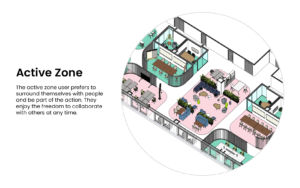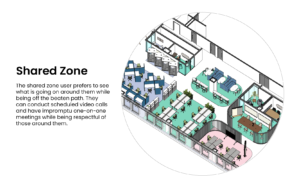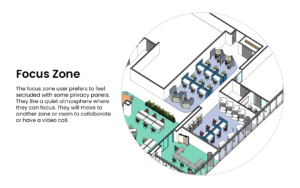From Cubicles to Comfort: Redefining Open Office Spaces with Zoned Furniture Solutions
By: Danijel Pocanic
Some consider the open office concept that gained popularity in the early 2000s, dead. “It’s too noisy”, or “There’s too much distraction and not enough privacy” became common complaints. However, we believe that creating a successful open office requires us to look deeper.
Research tells us that employees are returning to the office for purpose, not policy. Employers now recognize the workplaces as more – a space for productive collaboration, mentorship, and a tool to attract and retain top talent. All the while, employees desire a space that blends the comforts of home with the benefits of choice and control. They seek a workplace that embraces neurodiversity, stands for inclusivity, and prioritizes wellness, and looks to accommodate their unique preferences and needs.
Reimagining the “troublesome” open office floorplan through the implementation of zoned furniture vignettes, alongside the use of change management to introduce new ways of work, today’s workplace can be personalized, productive, and purposeful, meeting the needs of both the employer and employee.
Our designers recently conducted an experiment to determine what solutions might be possible using furniture only, no demo or dust required. The team created a workplace with three zones to meet specific user needs — Active, Shared and Focus — that are purposefully placed around the workplace to create comfort for the wide variety of users prevalent in the office today and their even broader number of work styles and preferences.

Active Zone users prefer to surround themselves with people and be part of the action. They enjoy the freedom to collaborate with others at any time. These zones might be located off elevator lobby, around interconnecting stairs, or in and around the work café to ensure that these active users are immersed in the hustle and bustle of the office.
These areas are activated with a buzzy energy and, like a hotel lobby, are inviting to those who are energized by being with and near others. People who want to be seen will often intentionally spend a portion of their day here, a signal that it’s ok to approach them for a conversation. And knowing that they will not be disturbing others, they’re free to talk on their phones or with colleagues. An out-of-town executive might also choose to sit here to make themselves available and visible for interaction with teammates when not in meetings.
With seating options for solo work or groups that boast varying heights, including standing options for more active meetings, Active Zones create pockets for collaboration and solo work. Plant dividers, bookcases, screens, and pergolas can be used to reinforce different seating vignettes and provide separation between conversations. Movable furniture allows for ease of configuration based on group sizes and encourages laptops, tablets, and other easy-to-move technology.
Change management keys here encourage active and social interaction.

Shared Zone, with moderate noise levels, allow users who prefer to see what’s going on around them while being just off the beaten bath. There is a medium pace to these areas and occasional conversation is not disruptive to those who chose to sit here. Located along common paths of travel, the Shared Zone serve as a buffer between the active and quiet zones.
These zones reinforce teaming and open collaboration, encouraging small groups to come together for conversations. Both open and enclosed spaces are offered to provide users with the choice of being heard or just seen. Users can conduct scheduled video calls and have impromptu one-on-one meetings, while being respectful of those around them. Employees whose sole reason to come to the office to collaborate with teams will thrive in this environment. These spaces encourage productivity, learning, and mentoring.
Furniture options are enhanced with robust technology; wall-mounted monitors or additional desk monitors provide high productivity. Lower or no panels on sit-to-stand benching allow easier eye contact and ease of engaging in conversations. Providing space where furniture tables and chairs are movable, white boards are available, and there is ample space to move for teaming sessions is a useful element to the Shared Zone.
Acoustical considerations are critical here, as they help muffle the sound between different groups collaborating. White noise, acoustical ceiling baffles and wall panels, and spaces with doors are key to keeping noise at a moderate level. Bookcases, acoustical screens, and specific design elements define zones, while helping soften noise.
Change management keys here are encouraging conference call and video conference calls be taken behind closed doors, while encouraging teams to reserve areas that are conducive to the activities they need to collaborate with white boards or digital technology.

The Focus Zone is ideal for users who prefer to be secluded with some privacy. The atmosphere is quiet and calm, where focus is key. Located well off the common corridors, or with buffers from corridors, these spaces are cozy, inviting, and most important – quiet.
Users come here for heads down focus work and understand that respecting the quiet atmosphere is of the utmost importance. Furniture is ergonomic, lighting is adjustable, and workstation panels are set higher as are the backs on lounge seating to ensure privacy. Phone booths can be useful in these areas so that unexpected calls can be taken without traveling too far. Should a Focus Zone user need to make a scheduled phone call or video conference, they would move to the Shared or Active Zone to do so.
Acoustical considerations beyond the furniture solutions also should be considered. White noise, high-quality ceiling acoustics, carpeted floors, and acoustical wall products all help enhance the experience, promoting quiet.
Change management keys to this area are enforcement of the “quiet car” expectations, respecting your colleagues who choose to work here and taking healthy conversations elsewhere.
Each of these solutions leveraging furniture to create spaces that meet the needs of varied workers are scalable, experimental, and should align with your company culture. Test a focus zone by selecting a far-away spot in your existing office and experiment with different furniture or separation ideas. The ideal solution reflects an inviting and comfortable space to empower all to be their best selves while at work, no matter the task at hand or their preferences or work style.

Let's Connect:
Danijel Pocanic,
Passionate about innovation and challenging traditional design ideas, Danijel translates clients’ values, brand, and vision into exciting destinations. He has a wealth of knowledge leading projects in the high-end workplace arena, including significant insights into hospitality, retail, and aviation sectors, and combines those influences to craft solutions that reflect the world where work and life are integrated more than ever. Danijel inspires and conceptualizes design direction and nurtures a culture of design-driven thinking within our Workplace practice. Reach out to him at dpocanic@nelsonww.com